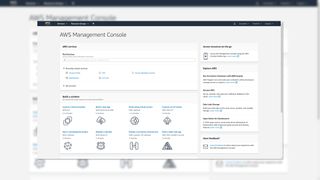What is Amazon S3?
Everything you need to know about Amazon S3, one of the world’s most popular cloud storage services

Amazon S3 is the company's premier object storage service, and one of the first products it brought to market. It remains one of the most popular storage services available today, working in tandem with, and underpinning, most of Amazon's other customer-facing services.
Amazon S3 is regularly updated with new features and storage capabilities, and patches that are designed to improve data protection and security.
What is Amazon S3?
Amazon Simple Storage – or Amazon S3 as it is more commonly known – is an object storage service. It offers unlimited, flexible cloud storage for seemingly any use case, whether that’s big data analysis, cloud-native applications, or mobile apps.

Object storage, or ‘object-based’ storage, is a type of architecture that manages data as an object, instead of files or blocks. Each object includes the data itself, a variable of metadata, and a globally unique identifier. The metadata element is key, as it is separated to support additional capabilities, such as the capture of application-centric or user-centric information for indexing, which is traditionally harder with fixed metadata.
Amazon S3's object storage approach is designed in a way that simplifies data admin. It removes the need for many basic storage functions, such as construction and management of logical volumes for disk capacity, or configuring settings to prevent disk failure.
Part of the reason Amazon S3 is so popular is its accessible pricing. Customers only pay for what they use, and there is no minimum service fee. It's also quite cheap, with the first 50TB, or the first month of use, being just $0.024 per GB – price accurate at the time of writing.
Amazon S3 security: What are buckets and keys?

Business value on AWS
Four key dimensions that will help to build a comprehensive business case for the cloud
Amazon S3 organises data into 'buckets'. These act as data repositories that can handle an unlimited number of objects, although each object is limited to a maximum size of 5TB. Buckets are designed in a way that allows for data to be organized and for access controls to be placed on objects.
Cloud Pro Newsletter
Stay up to date with the latest news and analysis from the world of cloud computing with our twice-weekly newsletter
Any object placed inside a bucket will be assigned a unique key, which helps locate and identify specific data objects within each bucket. This key resembles the structure of a URL, and is made up of the bucket number, the object number, and the region or data center the data is stored in.
Buckets must be appropriately configured in order to prevent unauthorized access to data. Historically, Amazon S3 buckets have been the source of a number of high-profile data leaks, including those belonging to the NSA, largely due to misconfigurations through human error.
Amazon has made efforts to minimize cyber security risk with constant updates and new features, and now includes a wealth of security controls for use across a variety of businesses.
For example, following an integration deal with CloudKnox in 2019, the company introduced a built-in identity and access management (IAM) tool to make it easier to monitor access controls.
Admins can also make use of the 'S3 Block Public Access' function, which is able to prevent access to specific buckets from those outside of a company or approved list. This function also overrides any existing blanket S3 permissions.
Read our guide to setting up and securing Amazon S3 for more information.
Amazon S3 latest features and updates
As a flagship product, Amazon S3 often receives new updates and innovations at the tech giant’s annual conferences. These can sometimes be tie-ins with other AWS services but it mainly sees new cost efficiencies and user improvements.
For instance, in 2021, Amazon added S3 Object Lambda, a service that allows users to add their own code to process data retrieval from their S3 buckets before it is returned to an application. The introduction of Lambda enables users multiple views of the same dataset, with capabilities to change the views at any time.
Another new function is S3 Glacier Instant Retrieval, which was launched during 2021’s AWS Re:Invent. This is a new archive storage class which offers low-cost storage for older datasets that are rarely accessed. AWS claims it is the fastest access to archive storage and offers 63% cost savings compared to previous services.
Bobby Hellard is ITPro's Reviews Editor and has worked on CloudPro and ChannelPro since 2018. In his time at ITPro, Bobby has covered stories for all the major technology companies, such as Apple, Microsoft, Amazon and Facebook, and regularly attends industry-leading events such as AWS Re:Invent and Google Cloud Next.
Bobby mainly covers hardware reviews, but you will also recognize him as the face of many of our video reviews of laptops and smartphones.






